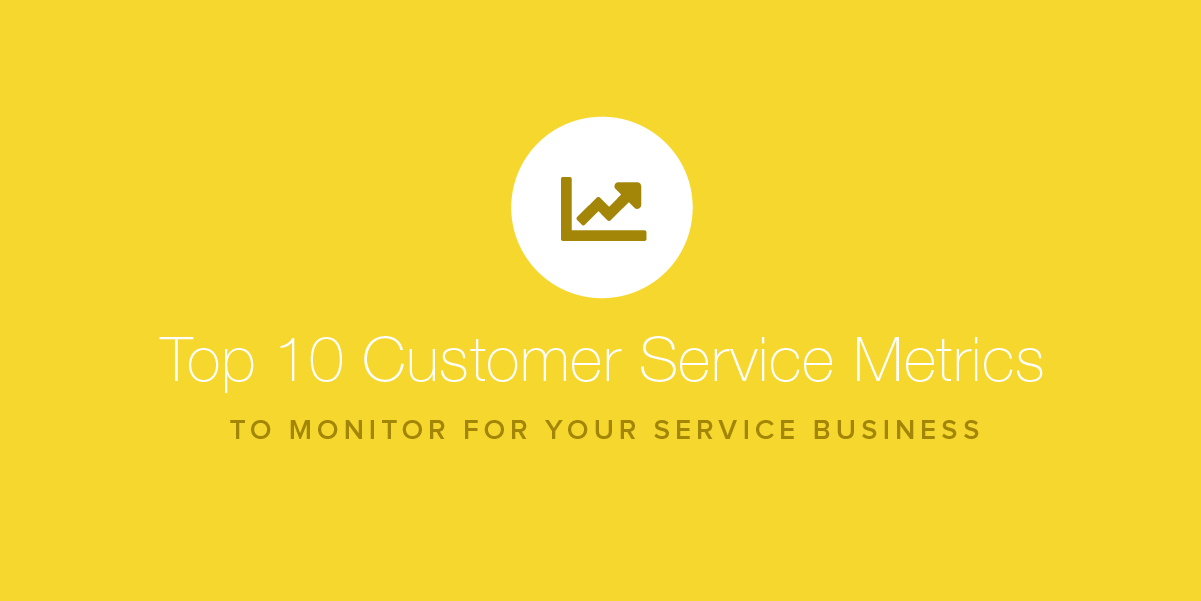Top 10 Customer Service Metrics To Monitor For Your Service Business
- June 30, 2018
- By: Vonigo
This article about customer service metrics is by Reuben Yonatan, Founder of GetVoip.
There is, of course, no quick, easy solution to grow a business, satisfy customers, and make revenues suddenly surge beyond a business owner’s wildest dreams. It takes more than just one solution to ensure that a business continues to thrive over the long term.
Measure, Understand, Grow
There are many techniques for increasing revenues. But, using key customer service metrics to better understand your company and ensure that it operates on a foundation of essential service principles is fundamental to your success.
Below, are the 10 most essential metrics for tracking your team’s success. These are the basics necessary to achieve and maintain consistently high levels of customer satisfaction.
Optimal Customer Service Metrics Tracking and Analysis
 First, choose a powerful comprehensive CRM platform from which to manage your service organization. Make sure the system you choose features an abundant variety of monitoring capabilities as well as strong analytics. Making the most of a CRM system’s tools, you can increase your customer retention, revenues, and team motivation, and reduce service quality issues and staff attrition.
First, choose a powerful comprehensive CRM platform from which to manage your service organization. Make sure the system you choose features an abundant variety of monitoring capabilities as well as strong analytics. Making the most of a CRM system’s tools, you can increase your customer retention, revenues, and team motivation, and reduce service quality issues and staff attrition.
Here are 10 service metrics that are essential for service businesses to track:
1. Customer Acquisition Cost (CAC)
CAC limits can be expected to fluctuate over time. Throughout a business startup, CAC is a metric that must be tracked as one of the highest priorities. Eventually, it serves more as a benchmark for the average cost of a new customer (or client).
CAC is calculated by a simple formula. CAC is equal to your total sales and marketing expenses for a given period, divided by your new customers during that time.
A high total CAC indicates that your business is spending more than it should on converting leads to new customers. Upper limits of what is appropriate for CAC is relative to the type of your business and industry, and what is considered typical for the particular revenue channels involved. For example, small business owners in moving, cleaning, or junk removal services need to work to accomplish a lower CAC than a much larger business.
2. Customer Attrition
Attrition (or “churn”) is the metric that reflects your business’s success in maintaining service quality, effective passive marketing programs, and profitable sales efforts by service personnel working directly with current customers. This number accounts for the customers who have stopped paying for your services. It is most important to service businesses dependent upon memberships or subscription-based revenue streams.
Comparing attrition to your customer retention provides a clearer view of what your company is actually delivering to your customers. Your team may be providing excellent service, or perhaps there is a problem in some aspect of the service model or at some point of service or with some service team member’s work.
Reaching out to inactive customers through your CRM system helps reduce attrition and, when properly executed, can generate a substantial amount of new activity in customer accounts. Keeping in contact through the regular telephony and online channels, via the CRM, can help you learn why customers discontinue their service, and it provides the ideal approach to bringing customers back to your service.
3. Conversion Rate
Your business’s sales conversion rate measures the percentage of qualified leads that enter your pipeline who become active (paying) customers. A higher conversion rate means either that you offer a very appealing service, or that you have a very effective Call to Action on your website or in the closing phase of your sales reps’ live pitch. Low conversion rates usually indicate that your service or your external branding efforts need evaluation and improvement.
This metric is supremely important for a business of any size or type. It is the indicator of the healthful or anemic flow of your organization’s lifeblood. Knowing this rate reveals strong service, marketing (active and/or passive) and sales performance, or all of the above. Or, it can expose a weakness in one or more of these performance areas. That can lead you to review other metrics, such as individual closing rates for sales reps, customer complaints sorted by reason, and marketing response rates.
4. Lifetime Value (LTV)
In basic terms, LTV is the total amount of revenue that an individual customer is projected to add to a company during the lifespan of the customer’s account. To calculate this estimate, first determine how long your customers usually continue doing business with your company, on average. After you determine the average customer account lifespan, multiply that number by the monthly revenue you expect to bring in from the average customer, to arrive at your customer LTV.
The LTV helps you assess your operations to ensure that what you are spending to remain active as a business indicates that your enterprise is financially viable. This information will help you to evaluate and identify areas of needed reprioritization and perhaps reorganization.
5. Revenue
The total of incoming revenues is the most basic of all business metrics. Focusing on the revenues your company is bringing in keeps you aware of trends and fluctuations that allow you to identify emerging issues and to address them before they become serious.
The most common forms of revenue for a service business is new sales, repeat sales, interest on receivables, late fees, service fees, subscriptions, supplementary services, and revenues from other sales channels, and more.
6. Prospect Referral Rates
For small businesses, like privately owned, such as a cleaning business, moving business, or HVAC service provider, referrals are critical. And, these rely on the success of your service program to cultivate the quality of customer relationships that generate effective word-of-mouth advertising for your brand. To calculate the referral metric, just divide your total number of leads acquired from existing customers by your total number of active account customers.
A high prospect referral rate means a lower CAC, because referral business comes with minimal or no customer acquisition cost to your business. It is also related to Net Profits, since a decrease in CAC means an increase in Net Profits.
7. Retention
Retaining loyal customers is the most critical necessity for the health of any business. These customer service metrics reflect the level of satisfaction, in terms of customer experience with your company as a whole, not necessarily just one department. It is important to know what your current customers really think of your brand.
After all, it is around 600% more costly to acquire a new customer than to keep a current one. (Inactive customers (those who have not purchased from you within a given timeframe typical for a repeat sale in your industry) is a metric that should also be targeted, to help you discover ways to keep customers engaged.
You can segment this metric into others in order to quantify satisfaction related to field service, products or additional experiences. This segmentation is important, especially for service businesses, as most consumers indicate that customer service is key to their sense of loyalty to a brand. To strengthen customer loyalty to your brand, maintain full awareness of the relationship between this metric and others, such as Revenues, Customer Attrition, Prospect Referrals and others.
8. Customer Complaints
The total of customer complaints is another metric that can and should be segmented into additional metrics branching from it. Outstanding complaints, resolved complaints, and escalated complaints for given periods are among some of the most useful of service metrics. Also complaints by service type, by the service contract, by employee, by date, and by resolution type, among others.
Tracking the complaint metric is the key to the core of service business principles to dedicate the team to problem-solving for customers in every context. This set of metrics identifies areas of needed improvement such as in the initial contact when today’s customer was a new prospect, during the encounter with every service representative during calls to provide service, in follow-up satisfaction calls, and during in-bound complaint calls.
Having a broad picture of customers’ feedback gives you critical information to help to implement the most effective solutions for customers. This can lead to a much stronger potential for minimizing attrition and achieving stable and growing retention rates. Service companies should also conduct NPS (net promoter score) surveys at regular intervals, to get an accurate read on how customers are feeling about the company overall.
9. Net Cash Available
Net cash is an important indicator of your business’s financial health. It reveals the degree of efficiency with which your company uses its funds to generate business. This metric is calculated by subtracting your investments and any increases in its working capital from operating cash flow. This most essential of metrics is key in considerations of capital expenditures or plans for follow-through on current projects.
10. Organic Growth
Sometimes called the “viral coefficient” of business metrics. This number reflects the growth of your company over time as it pertains to social branding activities. It indicates the changing status of your brand’s reputation. It’s a measurement of how information spreads across social platforms. It values social engagement regarding your brand, word-of-mouth referrals, promotions, and other activities occur that can impact your business’s growth.
The measurement involves several cycles or chunks to get a better idea of average growth levels. Let’s look at a quick example. The percentage of organic growth compares your original customer base to the number of invitations or promotional contacts you make who then convert to paying customers.
Tracking this metric over a series of operating periods will yield a more realistic growth rate measurement. Over time, the value of this metric becomes a valuable indicator of the success of your social branding.
Conclusion
Customer service metrics monitoring and analyses are information resources that are critical to your company’s growth and sustained financial health. For example, being aware of customer satisfaction brings your attention to customer’s issues. You can tune into their interests in various enhancements to existing services, alternative solutions, and the addition of new services. You can this info to target recommendations, implement promotions, deploy custom marketing campaigns, and so on.
Using the essential customer service metrics benefits your business. Beyond enabling more timely and effective actions to address customers’ needs and interests in the short term. Additionally, it provides invaluable insights for understanding what they are most likely to need or want in the future.
The business strategist equipped with the right information has a major competitive edge.
About the Author
Reuben Yonatan is the founder of GetVoIP, an industry leading business comparison guide that helps companies understand and choose a VoIP system for their specific needs. Follow on Twitter: @ReubenYonatan.
Want to learn more about how to grow your service business, using software that is designed to help measure key metrics? Book a free, private demo of Vonigo.



